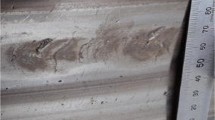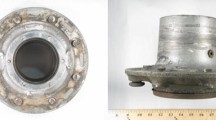Abstract
The relatively recent appearance of formerly rare vertical split rim wheel failures provides a good case study of how a shift in failure mode occurs when a material improvement is made to solve an existing problem. The mode of railroad wheel failures have changed three times over the past 40 years when the dominate failure mode has been identified and corrected. When the principal failure mode has been corrected the service life increases, but a new or previously minor failure mode assumes the role of principle failure cause. Because of the large population of railroad wheels in North American service, failure trends can be easily observed. This paper will discuss the evolution of failure mode with successive material and structural improvements.




Similar content being viewed by others
References
J.L. VanSwaaij, The mechanism of thermal cracking in railway wheels. Proceedings of the 3rd International Wheelset Congress, Sheffield, 1969, paper V.4
H.C. Iwand, D.H. Stone, G.J. Moyar, A theoretical and metallurgical model of martensite formation and tread spalling during wheel skid, Rail Transportation-1992, RTD, Vol. 5, (ASME, New York, 1992) pp. 105–116
D.H. Stone, Wheel failures due to brake heating—experience and solutions. Proceedings of the 8th International Wheelset Congress, Madrid, 1985 paper V.4
D.H. Stone, An interpretive review of wheel failure performance with respect to design and heat treatment. Proceedings of the 1988 ASME-IEEE Joint Railroad Conference, (ASME, New York, 1988) pp. 43–54
G.E. Novak, L.P. Greenfield, and D.H. Stone, Simulated operating stresses in 28-in. diameter wheels, ASME Paper 75-RT-10, April, 1975
Standard S-660, Wheel designs-locomotive and freight car-analytic evaluation, Manual of Standards and Recommended Practices, Section G, (Association of American Railroads, Washington, 2007)
S. Beretta, R. Roberti, A. Ghidini, G. Donzella, Deep shelling in railway wheels. Proceedings of the 12th International Wheelset Congress, Rome, September, 2001, Paper 23
Atlas of Wheel and Rail Defects, International Union of Railways (Paris, 2004) pp. 9–10
J.M. Galbraith, R.J. Fruehan, G.S. Casuccio, M.S. Potter, H. Matsuura, C.P. Lonsdale, Application of rapid inclusion identification and analysis to railway wheel steel microcleanliness. Proceedings of the 15th International Wheelset Congress, Prague, 2007
A. Meddah, D.H. Stone, A neural network analysis of the causes of vertical split rim wheel failure. Proceedings of the 17th International Wheelset Congress, Kiev, 2013, Paper 1–1
J. Kristan, D.H. Stone, J. Elkins, Effect of wheel loading on the occurrence of vertical split rim wheel failures. Proceedings of IMECHE 2004, (ASME, New York, 2004) Paper IMECE2004-59049
C.P. Lonsdale, J. Oliver, Further research into wheel rim axial residual stress and vertical split rim failures, ASME Paper JRC2012-74010, April, 2012
S.L. Dedmon, T. Fujimura, D.H. Stone, The effect of deformation on mechanical properties and shakedown of railroad wheels. ASME Paper JRC2014-3813, April, 2014
Author information
Authors and Affiliations
Corresponding author
Rights and permissions
About this article
Cite this article
Stone, D.H. Failure Mode Changes with Successive Component Improvements. J Fail. Anal. and Preven. 16, 515–517 (2016). https://doi.org/10.1007/s11668-016-0126-x
Received:
Published:
Issue Date:
DOI: https://doi.org/10.1007/s11668-016-0126-x




